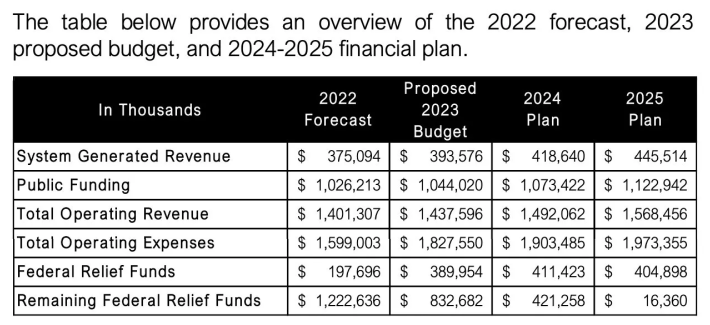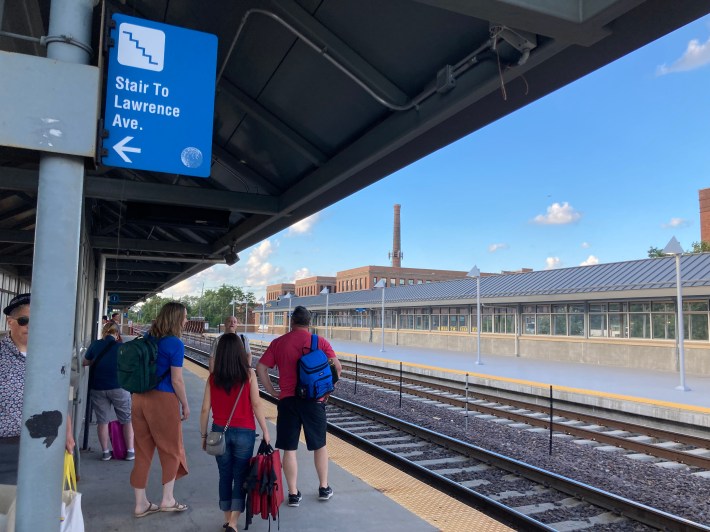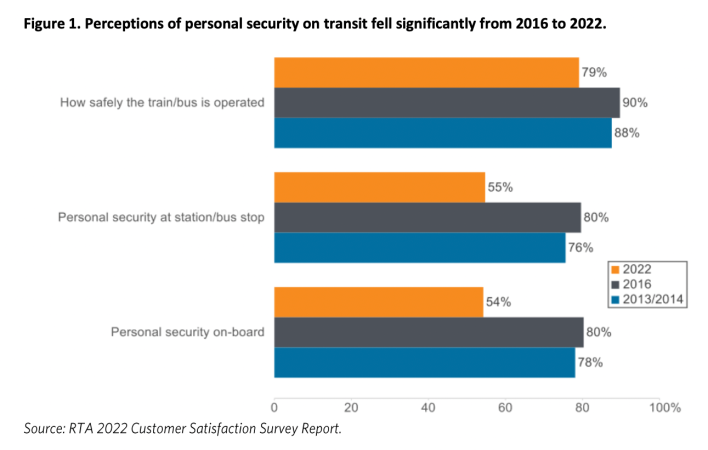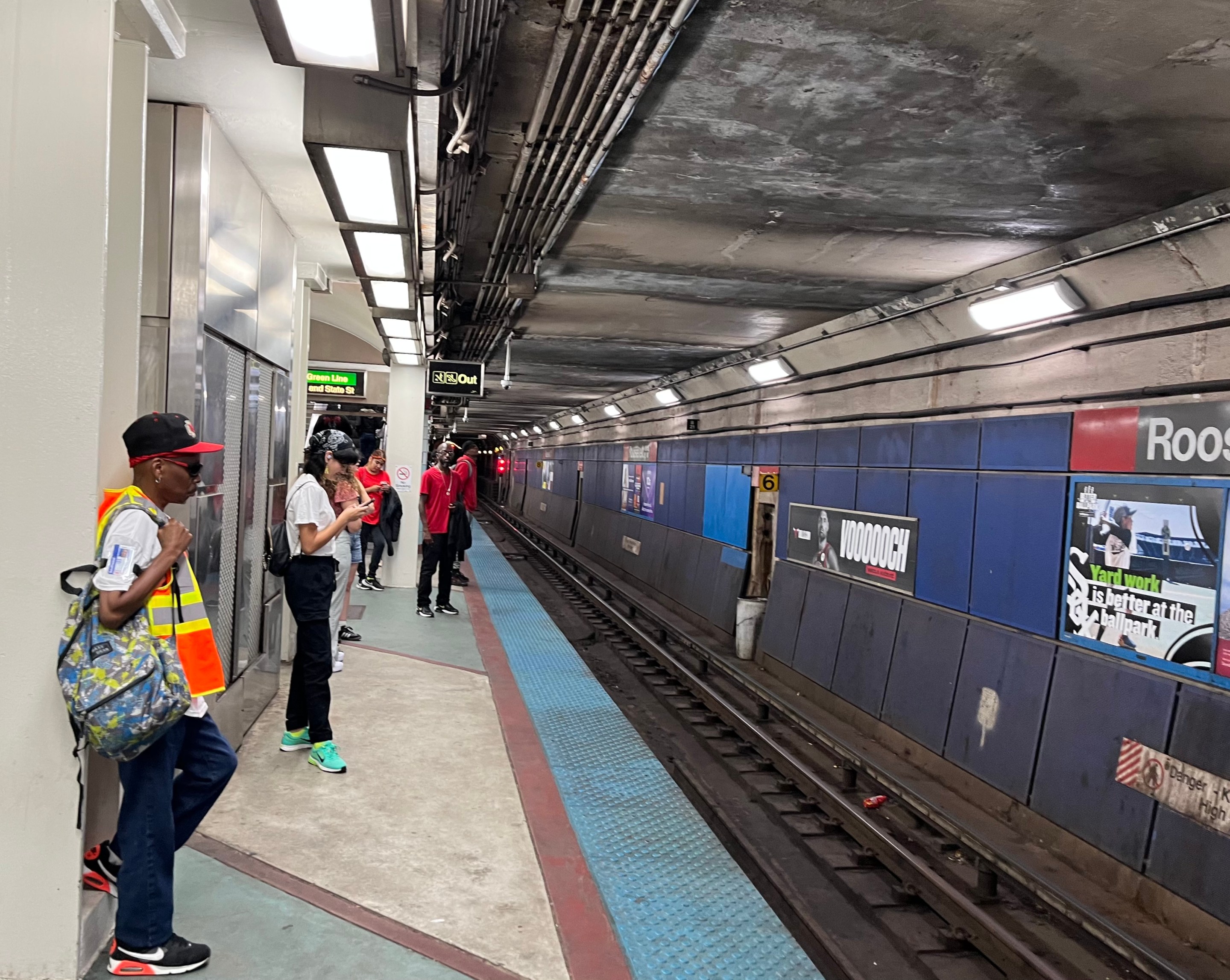
Remember last February when then-Mayor Lori Lightfoot insisted during a mayoral debate, "There’s not going to be a fiscal cliff for the CTA because the CTA... has budgeted in the out years to make sure that there are sufficient funds"? Her claim that the transit agency is not facing a pecuniary precipice didn't even jibe with the info that the agency, which she controlled, had put out. Its 2023 budget document included the chart below showing the system has been relying on hundreds of millions of dollars in federal relief funds a year to plug its COVID-era budget holes, and unless more federal aid is passed, the system will have a nearly $400 million gap by 2026.

Fortunately, the region's local transportation planning agencies have been doing a better job of grabbing the bull by the horns when it comes to addressing the predicted $730 million total CTA/Metra/Pace 2026 budget shortfall. A week after Lightfoot's remarks, the board of the Regional Transit Authority, which oversees the three systems, approved a strategic plan called Transit is the Answer outlining its five-year priorities.
That document noted, "At nearly 20 percent of the annual expense budget, this [$730 million] gap will prohibit any additional improvements to the regional system." It proposed ideas to help create "safe, reliable, accessible public transportation that connects people to opportunity, advances equity and combats climate change." Read Streetsblog's coverage of the RTA proposals here.
This week the Chicago Metropolitan Agency for Planning, the regional planning organization, provided an update on its own project to address the looming shortfall with an upcoming report, Plan of Action for Regional Transit. CMAP says "a diverse group of leaders from across northeastern Illinois" (see the full list at the bottom of this post) are working on a study "with recommendations that can help the region invest in a stronger and more financially secure transit system."

The Illinois General Assembly spurred this initiative by passing Public Act 102-1028 last January. The legislation mandates that CMAP develop legislative recommendations for Chicagoland's transit network.
The planning agency says their new document will build on Transit is the Answer's research and proposals, along with CMAP's January 2023 Mobility Recovery report.
The PART steering committee, which formed at the beginning of this year, includes reps from the business, community, environmental, labor, and civic sectors. The CMAP board and MPO [Metropolitan Planning Organization] Policy Committee will consider approving the report this fall. And CMAP hopes to submit the approved plan to Governor JB Pritzker and the Illinois General Assembly by New Year's Day.
"Big, bold solutions are needed to secure the financial viability of our region's transit system," CMAP stated on its website. "Through all the changes the system has experienced, one central fact remains true: A successful transit system is critical to the success of the region, its economy, health, and environment."
Here are details on steering committee meetings from earlier this year.
- January 18 (agenda, minutes)
- March 15 (agenda, minutes, presentation, project scope, governance problem statement)
- May 24 (agenda, minutes, presentation)
- July 19 (agenda, presentation)
The public is invited to comment at the next meeting Wednesday, September 6 from 9-11 a.m. at the CMAP offices, 433 W. Van Buren St., Suite 450.
The PART report will focus will on four main areas. There's "Financial viability and funding" with an emphasis on abolishing Illinois' 50 percent farebox recovery ratio, which requires transit systems to pay for half of operating costs through fares and other revenue sources like advertising. "Rider experience" will look at ways to provide "safe, secure, frequent, reliable, and affordable service" across Chicagoland. "Governance" will discuss ways to improve collaboration between CTA, Metra, and Pace. And "Community and economic development" will suggest ways to encourage equitable transit-oriented development.
The PART website includes a list of draft recommendations and potential funding sources. Some of the promising ideas include fare integration between the three transit systems to encourage more use of multiple systems for trips, and increased ridership overall. Another proposal for "Better buses" calls for working with the Illinois Department of Transportation and the Illinois Tollway to create more bus-priority highway infrastructure. And the "Safety and security" recommendation calls for introducing "transit ambassadors," unarmed workers who assist customers and improve rider perceptions of safety on regional transit, which have fallen since the pandemic started.

Obviously, solving the financial cliff problem while creating a safer, more efficient, and equitable Chicagoland transit network will be no easy task. But it's good that CMAP, state lawmakers, and the committee members appear to be serious about addressing these challenges.
Watch a video presentation about PART from the June CMAP board meeting below.
Steering committee members
| MarySue Barrett | MSB Policy Consulting/Brookings Institution |
| Randy Blankenhorn | Former Secretary, Illinois Department of Transportation |
| Carole Brown | PNC |
| Deborah Carroll | University of Illinois Chicago, Government Finance Research Center |
| Kevin Considine | Lake County Partners |
| Dan Cronin | Former Chairman, DuPage County Board |
| Mark Denzler | Illinois Manufacturers' Association |
| Derek Douglas | Civic Committee and Commercial Club of Chicago |
| Jacky Grimshaw | Center for Neighborhood Technology |
| Julie Hamos | Office of Medicaid Innovation |
| Darlene Hightower | Metropolitan Planning Council |
| Rob Karr | Illinois Retail Merchants Association |
| Jack Lavin | Chicagoland Chamber of Commerce |
| David Leopold | Microsoft |
| Juan Carlos Linares | Association House of Chicago |
| Tom Livingston | CSX |
| Justin Marlowe | University of Chicago, Harris School of Public Policy |
| David Narefsky | Mayer Brown |
| Jorge Perez | Lake Effect Community Development |
| Doug Pryor | Will County Center for Economic Development |
| Bob Reiter | Chicago Federation of Labor |
| Roberto Requejo | Elevated Chicago |
| Amy Rynell | Active Transportation Alliance |
| Stephen Schlickman | University of Illinois Chicago, College of Urban Planning and Public Affairs |
| Karen Tamley | Access Living |
| Jen Walling | Illinois Environmental Council |
| Sarah Wetmore | The Civic Federation |





